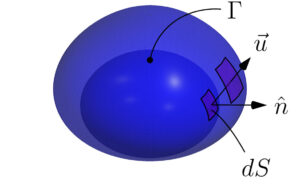Numerical Methods
I rely on numerical simulations for the resolution of multiflows in the context of water electrolysis. My focus is on the development of numerical methods that preserve the same features of the original setup. These include the conservation of basic physical principles, such as mass, momentum and energy.
My vision is to construct numerical methods that are mimetic representations of the physical laws.
In the particular case of water electrolysis, its simulation requires to accurately represent electrokinetics, (heterogeneous) mass transfer fluid flow. In order to advance the reliability of numerical simulations, I focus on constructing numerical representations of these phenomena that mimic their physical behavior at the discrete level.
Numerical simulations of electrokinetics is characterized by the solution of complex reaction-diffusion mechanisms and the solution of very thin boundary layers. Due to the different orders of magnitude that are present in many steps of an electrochemical reaction, the integration of its electrokinetic reactions becomes a stiff system of equations, which requires the use of extremely stable time integration techniques. Charge transfer reactions occur across the extremely thin double layer, which produces a sharp discontinuity of the electric field. This requires to employ special techniques for the resolution of electrostatics.
For approaching the fluid flows, Direct Numerical Simulations (DNS) tackle the Navier-Stokes equations directly, without any modelling assumptions. This implies solving the smallest scales of motion, which translates into a high computational cost. When multiple phases are present in the system, the system becomes even more challenging, particularly due to the impact of surface tension.

By looking into the fundamental governing equations, we identified the key geometric identity responsible for the exachange between kinetic and surface elastic energy. Introducing such an identity, we developed [1] a new method for the computation of surface tension which was able to mimic that behavior and so exactly preserve the transfer between potential and kinetic energy.
To accurately predict the detachment of bubbles, numerical simulations need to accurately predict the force imbalance on the surface. Unfortunately, state-of-the-art numerical methods do not preserve such an imbalance, and thus become physically inconsistent.
I apply Discrete Exterior Calculus (DEC) to develop new numerical methods. DEC is based on identifying the mathematical properties that correspond with basic physical principles (e.g.: conservation of mass, momentum and energy) and mimicking them at the discrete level, producing a so-called mimetic method. DEC is at the cornerstone of scientific computing, since it naturally accommodates (multi-)physics formulations and computational concepts.
DEC starts by describing vector calculus, which is used to describe most continuum mechanics, in terms of exterior derivatives. This generalization allows for a coordinate-independent formulation of the operators, segregating topological (i.e., exterior derivatives) from metric (i.e., Hodge star) operations. This process systematizes the construction of its discrete counterparts, and as a result most physical properties that where described in the governing equations are preserved as well, producing a so-called mimetic method.
This framework naturally accommodates mimetic and symmetry-preserving methods when they are formulated in a simple manifold (e.g., single-phase flows). However, when dealing with interface problems, the translation of discrete vector calculus operators is not immediate.
My research tries to develop a mimetic methods for embedded interface problems.

By using exterior calculus, DEC traces direct connection with the integration of discrete objects. This produces a mathematical hierarchy that ultimately connects the continuum and discrete concepts in a systematic way. This approach has been used as the guiding principle for the development of scientific software [2].
References
- N. Valle and F. X. Trias and J. Castro (2020): An energy-preserving level set method for multiphase flows. In: J. Comput. Phys., vol. 400, pp. 108991, 2020, ISSN: 10902716.
- Nicolás Valle and Xavier Álvarez-Farré and Andrey Gorobets and Jesús Castro and Assensi Oliva and F. Xavier Trias (2022): On the implementation of flux limiters in algebraic frameworks. In: Comput. Phys. Commun., vol. 271, pp. 108230, 2022, ISSN: 00104655.